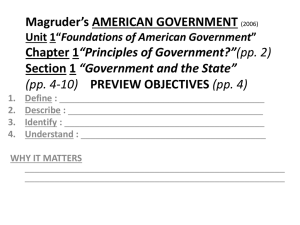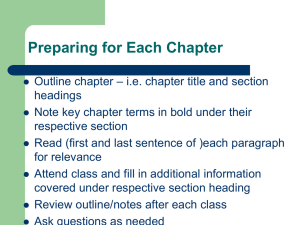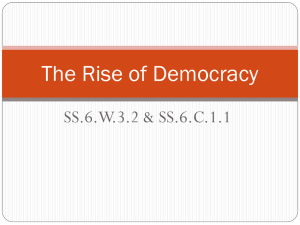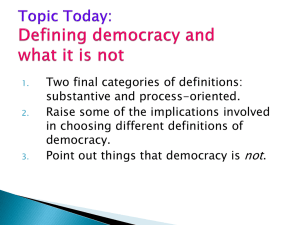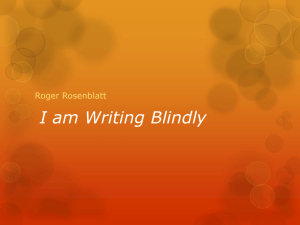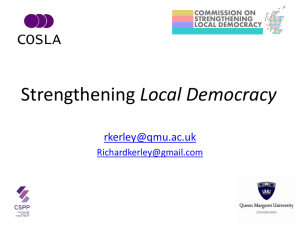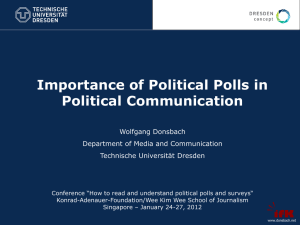Journalism 614: Communication and Public Opinion
advertisement
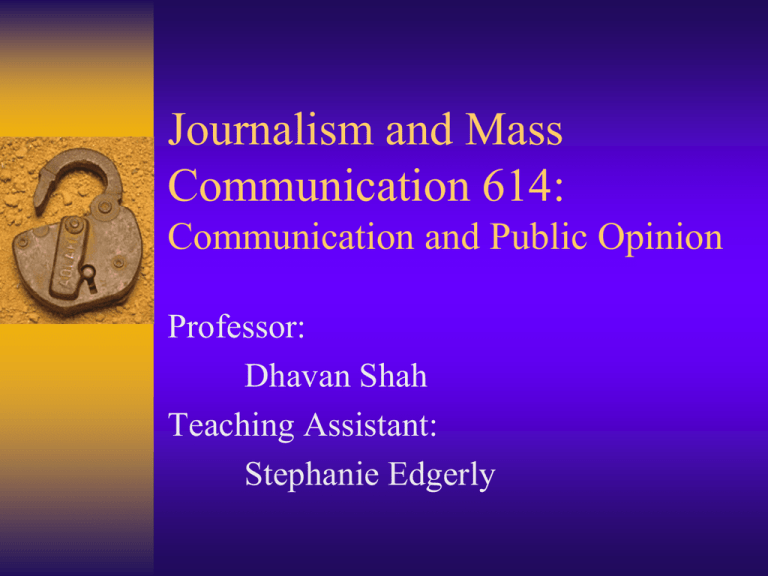
Journalism and Mass Communication 614: Communication and Public Opinion Professor: Dhavan Shah Teaching Assistant: Stephanie Edgerly Class will focus on (a) the philosophical and normative assumptions surrounding public opinion (b) the theoretical approaches to studying public opinion formation and change (c) the research processes involved in measuring opinion and understanding its change over time (d) the relationship of the public to polling, news information and marketing communications. Purpose Statement Examining the concept of public opinion Integrated approach to learning about: – Public opinion processes (analytical) – Public opinion research (applied) Learning by doing – Lab sections not only involve discussion of lectures but also include application of ideas • Project involving analysis of opinion trends Topical Outline Philosophical, normative assumptions – Covering Journalism and Strategic Comm. Theoretical approaches to understanding – Psychological and Sociological Orientation Role of Media and Communication – News, Entertainment, and Ad Effects and Perceptions of Influence Processes and Procedures of Studying Public Opinion – Content Analysis, Survey Research, and Experimental Methods Marketing Communication and Public Opinion – Overconsumption, and Political Consumerism Why Comm and Public Opinion? Public opinion as a communicative process – Public opinion as expression of views – Public opinion as outcome of media influence – Public opinion influence on communication Centrality of public opinion to: – Mass communication professions • Journalism, advertising, public relations, lobbying… – Both democratic and economic processes Why Public Opinion Research? Practical application of research – Growing value of research knowledge in range of professions, especially mass communication Developing analytical/critical skills Thoughtful evaluation of opinion data – Data workers – Media professionals – Information consumers Readings and Class Notes All readings and notes will be on the web http://www.journalism.wisc.edu/~dshah/J614/Index.html Readings: – Full set of readings available as a single zipped file • Will send a blind link to class email list. Class notes: – Will be posted by the morning of class, hopefully weeks before, so that you have them in advance The Class Research Project Groups of 4-5 people from lab section – (a) highlight a trend in public opinion – (b) predict how trend is a function media – (c) attempt to link it to shifts in content • Survey experiment of question wording • Content analysis of media for period of trend – (d) present their predictions and conclusions Group Project Requirement Opinion Trend Paper – Introduction and plotting of the changes in an opinion trend, and discussion of its import. 15 points toward your grade. Media Predictions Paper – Review literature and propose model predicting media-opinion linkages. 15 points toward your grade. Question Wording Paper – Propose a question wording experiment, including survey items and response categories. 15 points toward your grade. Content Analysis Work – Conduct a content analysis of media content to predict the trend in mass opinion. 30 points toward your grade. Final Presentation Over the last four class sessions, each group will then make a presentation (a) highlighting the opinion trend, (b) explaining their theory of media influence, (c) summarizing their findings for both the survey experiment and content analysis relating media and opinion. One presentation will be selected from each day as a “finalist.” “Finalist” groups will not have to take the final exam. Worth 50 points toward your final grade. Peer Evaluation of Group Work Team members evaluate each other – Minimizes free-riding on others work All evaluations are blind to other members – Evaluate each other member besides self Average of evaluations determines score – 25 points toward final grade Exams Midterm (50 points) Final (50 points) Multiple-choice and short answer questions – From lectures, labs, and readings Lab Sections Taught by TA or Professor Lab attendance is essential Lab activities – Presentation of key material – Discussion of lecture concepts – Exercises to illustrate concepts – Class project activities Lab activities 2 response papers – (10 points each) Mini-assignments – (10 points total) Participation – (20 points total) Grading Project responsibilities: Trend Selection Media Predictions Question Wording Experiment Content Analysis Work Group Presentation Peer Evaluation (Individual) Exams Midterm exam Final exam Lab Assignments Response Paper 1 Response Paper 2 Mini-Assignments Participation TOTAL POINTS 15 15 15 30 50 25 50 50 10 10 10 20 300 Grading Percentage – – – – – – – 93-100% 88-93% 83-88% 78-83% 73-78% 68-73% below 68% Grade A AB B BC C D F Any extra credit offered added in after final splits Course Overview Class Schedule Reading Schedule Lab Schedule Journalism 614: Setting the Stage What Is Public Opinion? How do we define it? How do we measure it? Who responds to it? What influences it? How are mass communication and mass opinion connected to each other? Conceptualizing Public Opinion Ways of thinking about public opinion: – Public opinion as the expression of views • Central to decision making in democracy • Central to consumer judgments in capitalist societies – Public opinion as a tool of social integration • Central to social harmony in communities • But also a tool for social control How Do Media Influence It? What effects do news, entertainment, and ad campaigns have on opinion? Do the media change our attitudes, or is the effect more subtle? Are the effects restricted to certain contexts and certain issues? What responsibility do mass media have regarding their impact? Krugman’s 1965 Thesis Advertising does not change attitudes; it changes perceptions of what should matter when buying. – Speaking against the limited effects paradigm in mass communication, which focused on news and electoral campaigns changing political attitudes – His speculation has been borne out, and found to help explain behavior of consumers and citizens Has quietly become the most cited article in Public Opinion Quarterly, a leading journal Consumers and Citizens Effects of advertising on consumer behavior well documented at the same time that news effects on public opinion was questioned. He proposed a new model of influence – Evidence of low involvement effects Little defensive reaction in low involvement conditions - nature of effect on opinion is fundamentally different that expected Example of Nazi Germany Propaganda Model - Hitler’s propaganda machine did not increase anti-Semitic attitudes but brought already existing antiSemitic attitudes into more prominent use for defining the everyday world – – – – Shifted the frame of reference Change in low involvement perceptions Conventional model focus to much on attitudes For many, politics is low involvement too! Democratic, Capitalist Societies Public opinion not only consequential for functioning of government, but for functioning of the economy and corporate interests. Public sentiment dictates the success or failure of capitalist enterprises due to consumer choice Corporate interests try to shape public opinion and choice through mediated communication – Greater choice of media options – Narrower targeting of audience segments Power of Public Opinion P.O. may be more powerful than voting – Benjamin Ginsberg’s argument: • Voting is formalized, channeled behavior – Ordered and not threatening to the political order – Reaffirms the status quo – Not a direct response to consumer sphere • Expression of opinion is “high-risk” – Tiananmen Square: Standing up to government – Environmental Activism: Standing up to corporations • More of a threat toward institutions than voting Need systems to monitor opinion Politicians may over-estimate its importance – Decision-making out of “fear” – Decision-making based on perception of effect • Consequences of ignoring public opinion unclear – E.g., Vietnam War • Initial fear of coming out against the war • Critics become vocal as they sense shift in opinion P.O. & Participatory Democracy Normative orientation: Ideal system – “what should be” Enlightened participation – Marketplace of ideas • Finding the truth through public discourse – Town meetings • soliciting input of citizen opinions Should democracies seek to maximize: – Citizen participation? – Input into decision-making? – Direct democracy? What if Public is Ignorant? Surveys demonstrate public ignorance – In 1986, a majority of Americans didn’t know the name of the Soviet leader (Mikhail Gorbachev) 1992 UMass Report: – – – – 86% could name Bush family dog (Millie) 89% know Murphy Brown was character criticized by Dan Quayle 15% knew Bush and Clinton support death penalty 5% knew both support cuts in capital gains tax More people could identify Judge who ran the “People’s Court” on TV than name a single Supreme Court Justice More Evidence… 22% of Americans believe Saddam Hussein helped plan and support the Sept. 11 terrorist attacks 24% believe several of the hijackers were Iraqis 41% say Saddam had “strong links” to al Qaida. -Harris Poll PIPA (Program on International Policy Attitudes) study finds FOX News viewers were the most misinformed about facts. CPI (Center for Public Integrity) study finds 935 Falsehoods in Pre-War Claims by Members of Bush Administration Direct or Representative Democracy? Philosophical origins: – Representative democracy: Plato – Direct democracy: Aristotle Walter Lippman vs. John Dewey – Lippman: Ordinary citizens incapable of rational decision-making – Dewey: Importance of creating opportunities for citizens to participate • Schools should build democratic skills Tyranny of the Majority James Madison concern: – “Tyranny of the majority” • A rationale for representative democracy • Concern for the suppression of minority views • Representative democracy as insulation – Enlightened leaders as an alternative to direct democracy’s dictatorship by the majority – Avoids problem of “winner take all” politics – Encourages negotiated policy/compromise Leaders Focused on Public Opinion Restoring the “tyranny of the majority” Governing by public opinion polls – Do politicians… • Choose issues according to polls? • Alter positions according to polls? • Silence themselves if views are unpopular? – The “never-ending campaign” Leading with an eye on approval ratings – Would politicians “wag the dog” to engage in conflicts to benefit from the “rally-round-the-flag” effect? Factors Elevating Public Opinion 1. Expansion of mass media – Greater interaction between politicians and public 2. Growth of public opinion measurement – Greater visibility of public opinion 3. Decline of Party Identification – Less predictable voting patters 4. Rise of independent voters – Larger proportion of swing voters 5. Decline of voter turnout – Mobilizing voters more difficult Power of Ignorant Opinion? If public opinion has become more important… If the population lacks important knowledge… …does the influence of public opinion lead to poor decision-making? – What can be done? Deliberative Opinion Poll Randomly sampled citizens brought in – Read information and listen to experts – Meet in groups for discussion – Survey questions measure their responses Poll data then represents: – Opinions of informed citizens • Overcomes problem of ignorant public – Opinions take into account opinions of others Deliberative forum televised to expand exposure Problems with Deliberative Polls Motivating people to participate – National Issues Convention (1996) had low rates What information to provide them with? What experts will speak to them? Language barriers in light of diversity Group think: norms and conformity pressure Did participation make a difference? – People are hesitant to change opinions Public Opinion and Economics Many of these same concerns apply to realm of corporations and consumer – – – – Most consumers are uninformed Most make impressionistic judgments Corporations are responsive to consumers Public opinion (i.e., corporate reputation) is critical to success Three Foundations of Reputation Economic performance – Brand sales and profits - market leadership Social responsiveness – Social consciousness and concern for consumers The ability to deliver to stakeholders – Think beyond the narrow range of end consumers The Normative Context Sets the stage for normative context of class – Artificial distinction between consumers and citizens - they are the same people! – The importance of understanding opinion as expression and a social force – The balance between representative and direct democracy in relation to government and policy
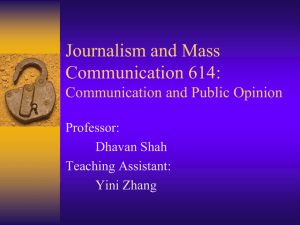
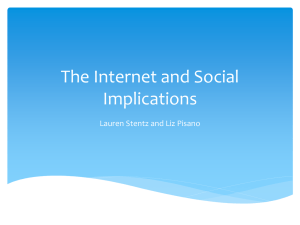
![“The Progress of invention is really a threat [to monarchy]. Whenever](http://s2.studylib.net/store/data/005328855_1-dcf2226918c1b7efad661cb19485529d-300x300.png)

